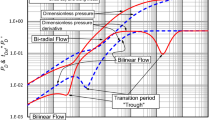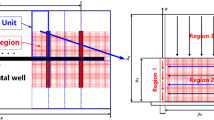Abstract
A computational algorithm is proposed for determining the acceptable range of bottom-hole pressure based on a composite indicator diagram constructed from well test data analysis in a deformable fractured porous oil reservoir. The behavior of the curves of drawdown and buildup pressure and their derivatives are analyzed in the case of a nonlinear elastic filtration regime in a fractured porous formation. A composite indicator diagram for determining the optimal bottom-hole pressure is constructed on the basis of the pressure buildup test interpretation and the Vogel’s method.



Similar content being viewed by others
REFERENCES
M. J. Fetkovich, ‘‘The isochronal testing of oil wells,’’ in Proceedings of the 48th Annual Fall Meeting, Las Vegas, NV, Sept. 30–Oct. 3, 1973, Paper SPE, No. 4529, pp. 78–84.
J. P. Brill and H. Mukherjee, Multiphase Flow in Wells (SPE, Richardson, TX, 1999).
V. N. Nikolaevsky, Advances in Well Test Analysis (Inst. Komp. Issled., Moscow, 2006) [in Russian].
H. Kazemi, M. S. Seth, and G. W. Thomas, ‘‘The interpretation of interference tests in naturally fractured reservoirs with uniform fracture distribution,’’ Soc. Pet. Eng. J. 4, 463–472 (1969).
A. O. DeSwaan, ‘‘Analytic solutions for determining naturally fractured reservoir properties by well testing,’’ Soc. Pet. Eng. J. 3 (16), 117–122 (1976).
J. E. Warren and P. J. Root, ‘‘The behavior of naturally fractured reservoir,’’ Soc. Pet. Eng. J. 03, 245–255 (1963).
M. Kh. Khairullin, A. I. Abdullin, P. E. Morozov, and M. N. Shamsiev, ‘‘Numerical solution of the coefficient inverse problem for a deformable fractured porous reservoir,’’ Mat. Model. 11 (20), 35–40 (2008).
A. I. Abdullin, ‘‘Approach to solving the inverse problem of filtration based on descriptive regularization,’’ Lobachevskii J. Math. 40 (11), 1892–1896 (2019).
K. S. Basniev, I. N. Kochina, and V. M. Maksimov, Underground Hydromechanics (Nedra, Moscow, 1993) [in Russian].
T. D. van Golf-Racht, Fundamentals of Fractured Reservoir Engineering (Elsevier Sci., London, 1982).
V. N. Nikolaevsky, Geomechanics and Fluid Dynamics (Nedra, Moscow, 1996) [in Russian].
G. I. Barenblatt, Yu. P. Zheltov, and I. N. Kochina, ‘‘On the basic concepts of the theory of filtration of homogeneous fluids in fractured rocks,’’ Prikl. Mat. Mekh. 5 (24), 852–864 (1960).
H. Aziz and E. Settari, Mathematical Modeling of Reservoir Systems (Nedra, Moscow, 1982) [in Russian].
E. R. Badertdinova, M. Kh. Khairullin, M. N. Shamsiev, and R. M. Khairullin, ‘‘Numerical method for solving the inverse problem of nonisothermal filtration,’’ Lobachevskii J. Math. 40 (6), 718–723 (2019).
Author information
Authors and Affiliations
Corresponding author
Additional information
(Submitted by D. A. Gubaidullin)
Rights and permissions
About this article
Cite this article
Abdullin, A.I., Shamsiev, M.N. & Khairullin, M.K. Numerical Well Test Analysis of Fractured Porous Reservoirs with Consideration of Stress-Sensitivity Effect. Lobachevskii J Math 42, 2077–2081 (2021). https://doi.org/10.1134/S199508022109002X
Received:
Revised:
Accepted:
Published:
Issue Date:
DOI: https://doi.org/10.1134/S199508022109002X




